The Samsung Galaxy Note5 and Galaxy S6 edge+ Review
by Joshua Ho on October 2, 2015 8:00 AM ESTBattery Life
Battery life is undoubtedly one of the most important parts of the user experience of any mobile device. One of the major reasons why many people use phablets is to get better battery life, as the PCB size of a phablet is often roughly similar to what you’ll see in a smartphone, but the battery will be bigger to fill the available space. As a result, a phablet has a higher proportion of battery than a smartphone. This inherently means that battery size will scale faster than platform power. In order to test this metric, we use a number of different tests ranging from display-bound web browsing to SoC-bound CPU and GPU load tests. In order to eliminate confounding variables, we test all devices from the same ASUS RT-AC68U router for WiFi testing, and in strong LTE/3G reception for mobile web browsing, in addition to setting all devices to an average of 200 nits on the display.
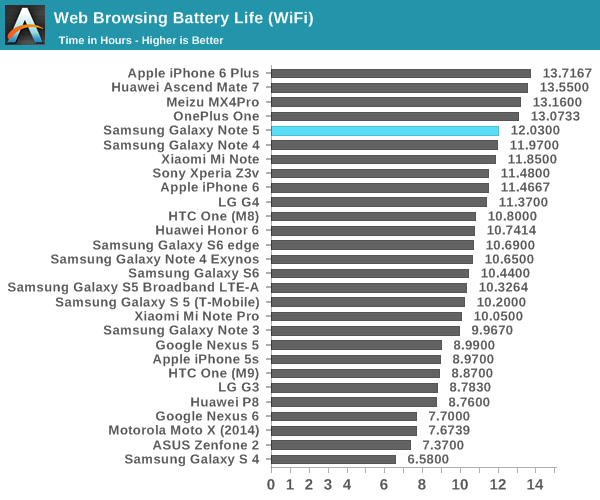
In our first test of WiFi web browsing, the Galaxy Note5 performs identically to the Galaxy Note 4. This might be surprising because the display is the same size and resolution as the Galaxy Note 4 with a smaller battery than the Galaxy Note 4. However, the smaller battery is compensated for due to improvements in SoC and display efficiency. In particular, the move from a planar 28nm process to a 14nm FinFET process dramatically reduces power consumption on the SoC.

In LTE battery life, we see a noticeable drop relative to WiFi battery life. It’s likely that this is mostly due to the power consumption of the Shannon 333 modem present in these devices. There’s not much else to say here, but battery life is still good.
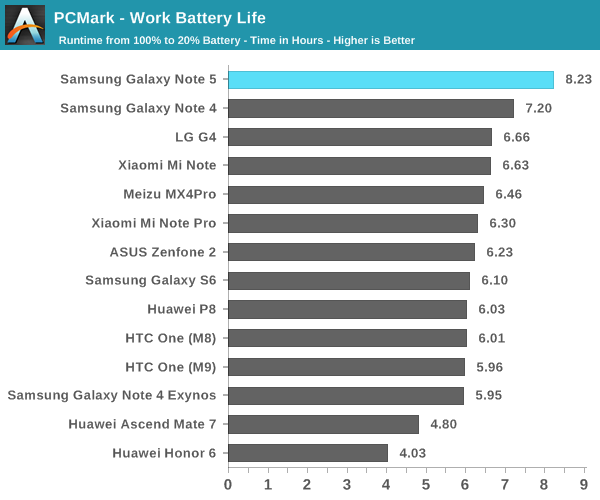
Moving past our mostly display-bound web browsing test, PCMark provides a much more balanced look at battery life as APL tends to vary a bit more with content like videos and photos instead of just webpages, and the CPU component is much more strongly emphasized. Here we can really see the Note5’s Exynos 7420 stretch its legs as it keeps a high performance level with long runtime.
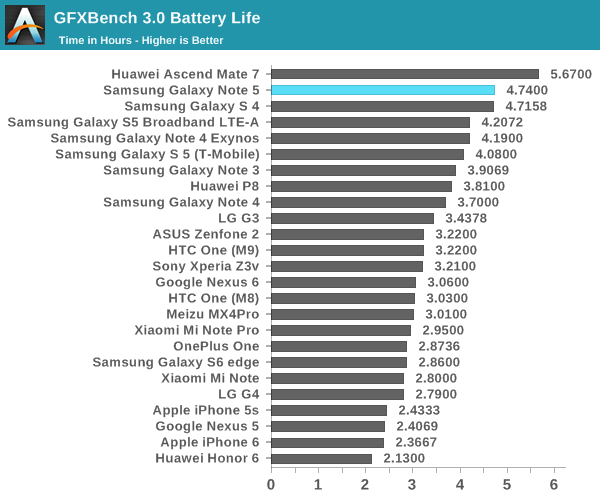
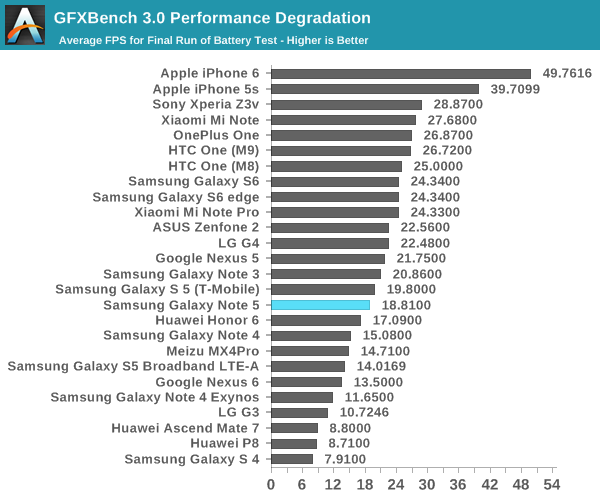
In our sustained SoC-bound workloads, GFXBench shows a healthy improvement over the Galaxy S6. Although we’re unable to test in perfectly controlled temperatures, it looks like Samsung has improved the throttling behavior of the SoC as the throttling appears to be more graceful rather than sinusoidal, and the result is a pretty significant jump in runtime over most devices.
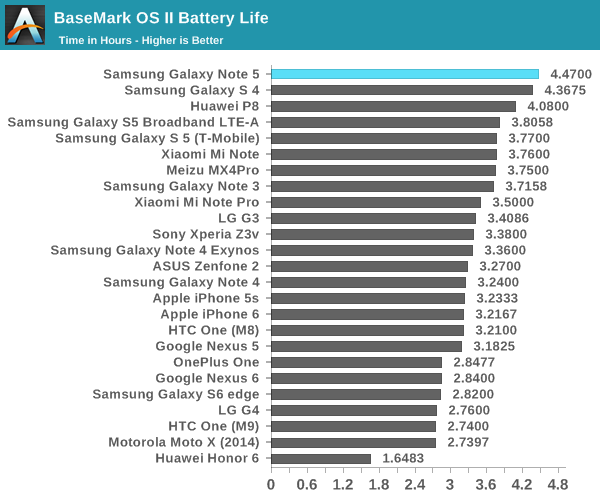

In Basemark OS II, we see a pretty significant uplift in runtime when compared to something like the Galaxy S6 or Note 4. The runtime increase isn’t just due to excessive throttling though, as the battery score shows that this isn’t just a case of throttling the CPU until the runtime is an improvement over past devices.
Overall, if you’ve read the Galaxy S6 review it’s pretty fair to say that you’ll know what to expect from the Galaxy Note5. Battery life is roughly equivalent to the Galaxy Note 4 despite the smaller battery, and due to the greatly improved Exynos 7420 SoC relative to 2014 SoCs SoC-bound cases will show pretty healthy improvements as long as you’re controlling for performance.
Charge Time
While normally battery life is the primary area of concern for a smartphone, in some cases it’s important for a phone to charge quickly. We can all claim to be perfect but one of the simplest cases for faster charging is forgetting to plug the phone in before going to sleep, so the maximum allowable charge time goes from something like 6 hours to an hour at best. As a result, a faster charger can dramatically improve practical battery life in any situation where you have limited time to charge. This can be accomplished by increasing either the current or voltage of the charger. The original quick charging standards improved charge rate through higher current, but this eventually hits a wall due to resistance in the wire. In order to increase the total amount of power delivered without increasing the thickness of the cable used voltage was increased in the case of newer standards like QC 2.0. In the case of the Galaxy Note5 and Galaxy S6 edge+, we’re looking at the same 9V, 1.67A QC 2.0 compatible charger that shipped with the Galaxy Note 4. In order to test this properly, we log the time it takes for the phone to charge by running a timer until the charger power draw hits a point that represents 100% battery.
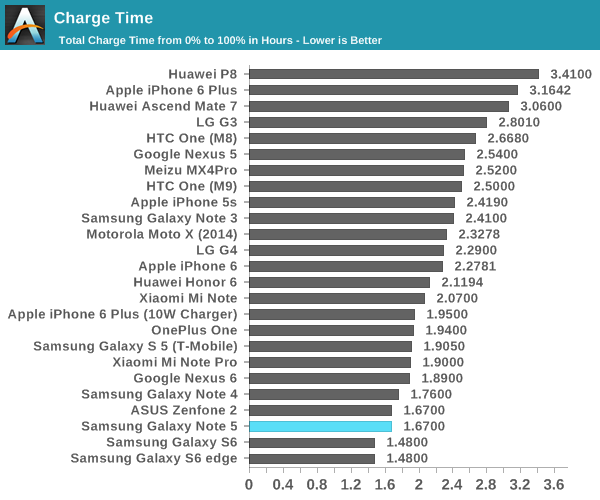
It probably isn’t a surprise, but charge time ends up similar to the Galaxy S6 and Galaxy Note 4. I suspect that we’ll be waiting until QC 3.0 to be able to see significant improvements as the current standard doesn’t have particularly fine-grained voltage scaling according to cable and phone conditions. Interestingly, the wireless fast charger is actually not too far off from the wired charger as it indicates 100% around 1.84 hours into charging which is almost identical to the wired fast charger.


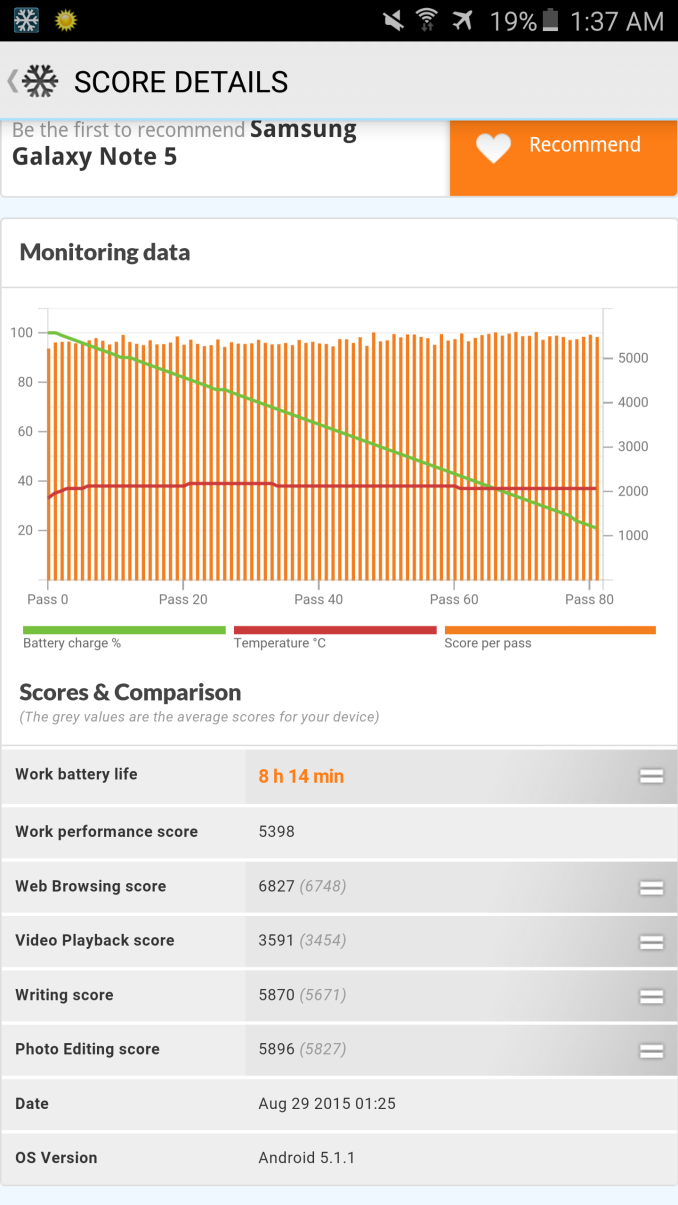
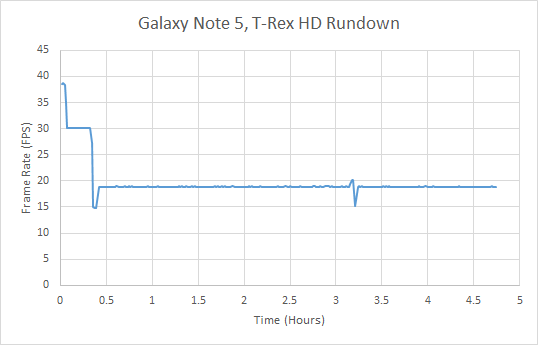
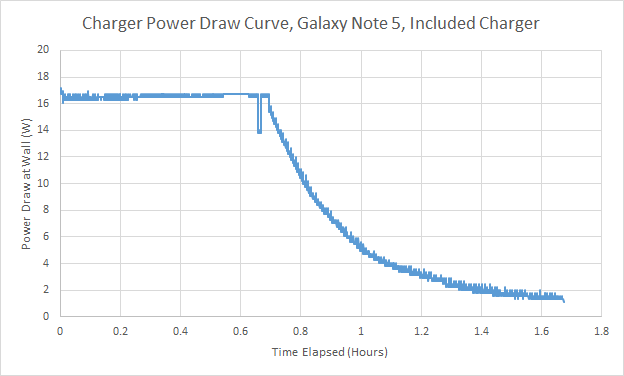
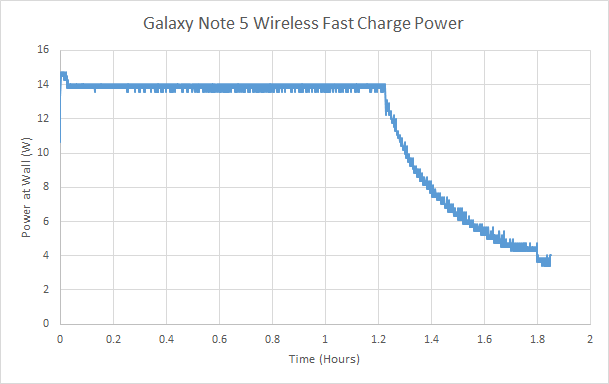








225 Comments
View All Comments
lilmoe - Sunday, October 4, 2015 - link
Samsung is selling Exynos to anyone willing to buy...Tech_guy - Friday, October 2, 2015 - link
Why weren't 6s benchmarks included? This is stupid, and misleading. You're trying to make Samsung look good. It'll embarrass the Note 5, like iPhone 6s is about 4 times the onscreen graphics performance lol. Did Samsung increase their advertising on Ananadtech.com?freeskier93 - Saturday, October 3, 2015 - link
Dude chill out, these phones were released before the 6s/+. The full 6s/+ review isn't even out yet so it only makes sense.thedons1983 - Sunday, October 18, 2015 - link
What a pathetic faggot. Please don't breed, as the world has enough ill-informed morons as it is!!secretmanofagent - Friday, October 2, 2015 - link
No mention at all of it dropping multitasking? This is an important question.randomlm - Friday, October 2, 2015 - link
A few errors in this review,1 . At the front page, Note 4 rear camera's aperture is stated as F/2.0, it is actually F2.2
2. At the battery life page it is stated that note 4 has a "planar 20nm process". This is only true for Exynos Note 4 which has the 5433, but it appears on the front page that the Snapdragon Note 4 is being compared instead, which has a 28 nm process.
3. On the camera architecture page, the front camera's aperture of Note 4 is stated as F2.4. It should be F1.9.
4. I disagree with the line "Samsung has actually managed to implement low light image processing that's good enough to beat" ( Lightroom's noise reduction ability). Not a fair comparison. In JPEG shots, samsung has been known to always activate "night mode", which uses a sort of "image stacking" process by combining (my guess is 3) images taken in quick succession to reduce noise (and improving the SNR of an image). By using raw, only one image of shutter speed 1/7 is taken. With only 1 image worth of data to process, the lightroom processed image will definitely lose out! But your point is there, that samsung's really good at JPG processing for night photos.
Still a pretty good review, thanks.
Ryan Smith - Friday, October 2, 2015 - link
Thanks randomlm. I've taken care of 2 and 3. As for item #1, in my notes I have it down as 2.0, but I will get Josh to check this.beck2448 - Friday, October 2, 2015 - link
Note 5 is awesome. Moved up from the 3. Screen is clearly the best in business including the iphone.Fast and great camera. Low light pix much better. It's a winner.
nerd1 - Friday, October 2, 2015 - link
Okay now I absolutely hate anandtech reviews. THEY INTENTIONALLY OMITTED ANY COMPARISON THAT MAKE APPLE DEVICES LOOK BAD.-Display review lacks contrast and outdoor contrast (both AMOLED dominates)
-Browser benchmark uses terrible mobile chrome, not stock browser which is way better.
-Processor benchmark lacks any multithread benchmarks (like geekbench multi)
-NAND R/W results makes absolutely sense at all, compared to this http://blog.gsmarena.com/samsung-galaxy-s6-storage...
-Camera comparison only shows the focus lag comparison and no resolution / noise / dynamic range that actually matters
I'm really surprised to see this low level of journalism at anandtech. Why cherry pick test results to make apple device look the best? Even worse thing is that most people will take those graphs as 'unbiased and technical'
Yanic - Saturday, October 3, 2015 - link
If this is the case, then this will be the last Anandtech review I ever read. Really sad.